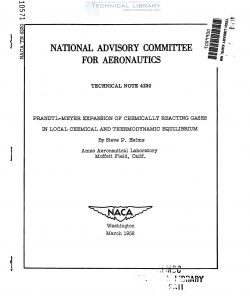naca-tn-4230
- Version
- 52 Downloads
- 686.27 KB File Size
- 1 File Count
- February 4, 2017 Create Date
- February 4, 2017 Last Updated
National Advisory Committee for Aeronautics, Technical Notes - Prandtl-Meyer Expansion of Chemically Reacting Gases in Local Chemical and Thermodynamic Equilibrium

It is found that Prandtl€Meyer flow, in which chemical reactions
are occurring and are in equilibrium, can be simply and exactly calcu-
lated. The property ofgaiirfihififi‘gbverns the flow is found to be a
quantity which depends only on the ratio of enthalpy to the square of
the speed of sound; the analogous quantity for an inert gas depends only
on the ratio of specific heats. The maximum angle through which the
flow may turn is generally larger when chemical reactions are occurring
than it is in nonreacting air. A numerical example shows that the pres—
sure variation with angle, as well as temperature and Mach number varia-
tions,nmy be considerably affected by the presence of the chemical
reaction.
At the high temperatures encountered in hypersonic flight, the air
may no longer be regarded as an inert gas. It does not have a constant
ratio of specific heats, 7, nor does it generally obey the simple equa-
tion of state, p/p = RT. These thermodynamic features reflect the fact
that at high temperatures molecular vibrations are excited and chemical
reactions are taking place in air. Because of this, any flow solutions
depending on constancy of 7 and the perfect gas law are not valid.
One elementary supersonic flow solution is the Prandtl-Meyer expan-
sion around a corner. In this paper the theory of the Prandtl-Meyer
expansion is extended to include high.temperature flow in chemical and
thermal equilibrium“ When onyx molecular vibrations are active, and no
chemical reactions occur, one can still use the usual flow equations in
terms of 7, if the appropriate function of temperature is inserted for
7 (see ref. 1). HOwever, when chemical reactions are occurring, then 7
is no longer a useful concept in the Prandtl-Meyer flow.
Instead of working with 7, we shall employ a quantity n to des—
cribe the thermodynamics of the gas, because it is n and not 7 which
enters into the flow equations at high temperatures. When no reactions
are taking place, q reduces to (y+l)/(7-l). In the present analysis,
it will be shown that by introducing also an auxiliary variable W, the
Prandtl—Meyer expansion can be simply and exactly calculatec for equi-
librium flow without employing any iterative procedures or extensive
numerical integrations.
| File | Action |
|---|---|
| naca-tn-4230 Prandtl-Meyer Expansion of Chemically Reacting Gases in Local Chemical and Thermodynamic Equilibrium.pdf | Download |
Comment On This Post